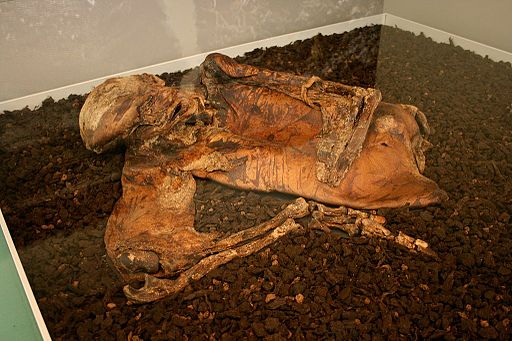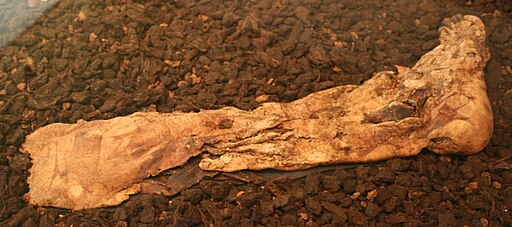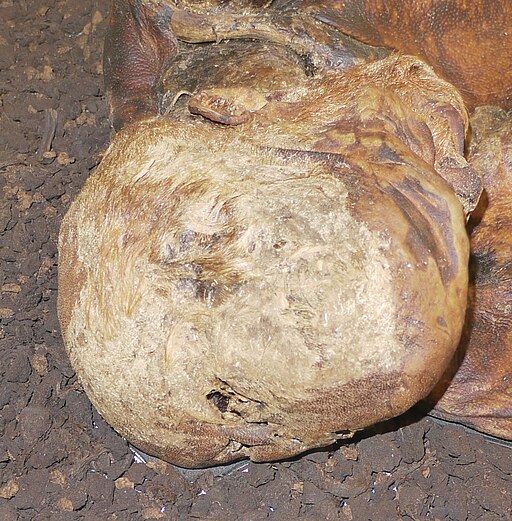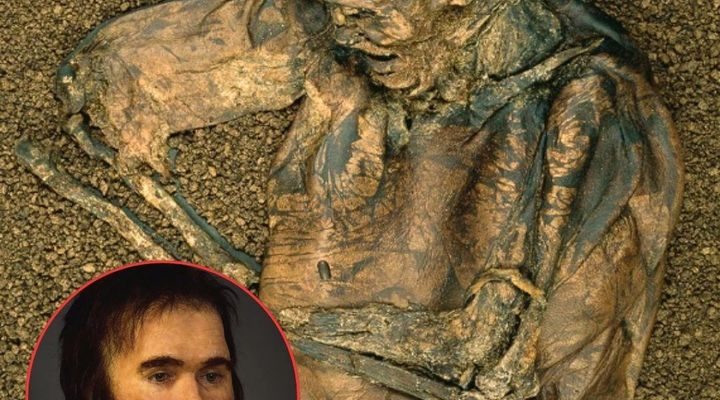Lindow Man is the preserved body of a man thought to be from between 2 BC and 119 AD, from either the Iron Age or Romano-British period. Lindow Man marked the first discovery in Britain of a well-preserved bog body.

The body retains a trimmed beard, mustache, and sideburns of brown hair, as well as healthy teeth with no visible cavities, and manicured fingernails, indicating he did little heavy work.
In life, Lindow Man would have been about 5’8″ (1.73 m) tall and weighed about 132 pounds (60 kg). His age at death was around the mid-20s.
As a result of the decalcification of his bones and pressure from the peat, his skull was discovered distorted. Apart from a fox-fur armband, Lindow Man was found entirely naked.
At the time of death, Lindow Man was a healthy male in his mid-20s, and he may have been someone of high status, as his body shows little evidence of rough work.
There has been debate over the reason for Lindow Man’s death because the nature of his demise was violent and ritualistic.
After the last meal of charred bread, Lindow Man was strangled, hit on the head, and his throat was cut.
His recovered body has been preserved by freeze-drying and is on permanent display at the British Museum.

Bog Body
A bog body is a human cadaver that has been naturally mummified in a peat bog. Such bodies, sometimes known as bog people, are both geographically and chronologically widespread.
Bog Bodies have been dated to as far back as 8000 BCE. Bog bodies are found in peat and are partially preserved, with the levels of preservation varying widely from perfectly preserved to mere skeletons.
Unlike most ancient human remains, bog bodies often retain their skin and internal organs due to the unusual conditions of the surrounding area. The combination of highly acidic water, low temperature, and a lack of oxygen preserve but severely tan their skin.
While the skin is well-preserved, the bones are generally not due to the dissolution of the calcium phosphate of bone by the peat’s acidity.
The oldest known bog body is the skeleton of Koelbjerg Man from Denmark, who has been dated to 8000 BCE, during the Mesolithic period.
The oldest fleshed bog body is that of Cashel Man, who dates to 2000 BCE during the Bronze Age.
The overwhelming majority of bog bodies date to the Iron Age and have been found in northwest European lands, particularly Denmark, Germany, the Netherlands, the UK, and Ireland.
Such Iron Age bog bodies typically have several similarities, such as violent deaths and a lack of clothing.
Archaeologists believe that they were killed and deposited in the bogs as a part of a widespread cultural tradition of human sacrifice or the execution of criminals.
A catalog has been created of over 1,800 bog bodies that he had counted starting from 1939. The most recent bog bodies are those of soldiers killed in the Russian wetlands during World War II.

Discovery of Lindow Man
Lindow Man was discovered in a peat bog at Lindow Moss near Wilmslow in Cheshire, North West England. The human remains were found in 1984 by commercial peat-cutters.
The owners of the land on which Lindow Man was found donated the body to the British Museum. Lindow Man’s official name is Lindow II, as there are other finds from the area.
Lindow Woman was discovered the year before from the same area, and other body parts have also been recovered.
Lindow I (Lindow Woman) refers to a human skull, Lindow III, to a “fragmented headless body,” and Lindow IV to the upper thigh of an adult male, possibly that of Lindow Man.
After the discovery of Lindow Man, an archaeological excavation at Lindow Moss started in 1987. Over 70 pieces were found, with the last discovery was that of Lindow IV in 1988.
Lindow Man at the British Museum
Lindow Man Death
Lindow Man suffered a violent death. His injuries included a V-shaped, 3.5-centimetre (1.4 in) cut on top of his head. A relatively blunt object caused the blow on top of the head.
The blow, possibly from a small axe, fractured the skull and drove fragments into the brain. Swelling along the edges of the wound indicated that he did not die immediately after being struck.
His body indicates ligature marks on the neck where a sinew cord was found. The ligature marks on the neck were caused by tightening the sinew cord found around his neck, possibly a garrotte.
He also has a possible stab wound in the upper right chest, a broken neck, and a fractured rib.
It is not possible to confirm whether some injuries took place before or after death, due to the body’s state of decay.
The physical evidence allows a general reconstruction of how Lindow Man was killed, although some details are debated, it does not explain why he was killed.
Although dated to the mid-1st century AD, the type of burial of Lindow Man was more common in the pre-historic period.
Scholars widely believed that bog bodies demonstrating injuries to the neck or head area were examples of ritual sacrifice. Bog bodies are associated with Germanic and Celtic cultures.
In the case of Lindow Man, the death may be an example of human sacrifice and that the “triple death” of throat cut, strangled, and hit on the head was an offering to several gods.
The wide date range for Lindow Man’s death (2 BC to 119 AD) means he may have met his demise during the time of the Roman conquest of northern England in the 60s AD, after which the Romans outlawed human sacrifice.



